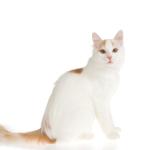Turkish Van

With it’s characteristic fluffy and cottony coat, captivating look and sociable character, it’s no surprise that the Turkish Van cat breed is so widely desired. Whether you’ve just adopted a Turkish Van or are thinking of adopting one, this article is for you!
For more about the origin, care, character, characteristics and health of the Turkish Van cat breed, keep reading here at AnimalWised.
- Asia
- Turkey
- Category I
- 7-11
- 11-13
- 13-17
- 17-22
- 22-30
- 8-10
- 10-15
- 15-18
- 18-20
Origin of the Turkish Van
These felines are endemic to Lake Van, the largest lake in Turkey (to which they owe their name). Turkish Van origin dates back thousands of years, accompanied by a beautiful legend, which claims that these cats came to Lake Van after the Universal Flood, on Noah's ark. This also explains why it is among the oldest cat breeds in the world.
Depending on the religion, this legend has two versions, which aim to clarify the characteristic marks of a Turkish Van’s coat. According to the Jewish version of this story, the marks are a result of the hand of God himself, who touched the first Turkish Van cat on those now marked areas, which would be the head and tail. According to Islam, however, Allah is responsible for this touch which marked the cat. This is why, today, felines that have marks on their heads and tails carry "the footprint of Allah."
In truth, however, this cat breed was already present in the time ofthe Hittites people (XXV BC - IX BC) and is represented in many of this civilization’s findings. From Lake Van, the Turkish Van expanded first to Iran and Armenia, finally reaching the United States through the hands of an English breeder.
Physical characteristics of the Turkish Van
The Turkish Van is considered a medium to large size cat breed, with a weight that varies between 5-7 kilograms. These cats are robust and muscular, with a strong and slightly elongated body. The hind legs of a Turkish Van are usually slightly longer than the front one.
A Turkish Van’s head is triangular and with a slightly downward-facing inclination. Its eyes are oval, large and incredibly expressive. In many cases, they carry the heterochromia gene.
The most characteristic feature of these beautiful cats would be their thick, semi-long and silky coat. They only have one layer of hair, which does not tangle easily. The base coat color of a Turkish Van is usually white with reddish marks. Additional colors such as chestnut, blue, cream or turtle may also be accepted.
For more about this fascinating feline, we recommend reading our article where we list the 12 largest cat breeds.
Turkish Van character
These funny felines are famous for their passion for water, which they love! They are also very playful and sociable cats, provided that sufficient time has been devoted to their socialization when young.
The Turkish Van is a perfect cat for children. They love to play and need to be well stimulated, both mentally and physically. If you have a Turkish Van, we recommend keeping it entertained with stalking and hunting games: moving mice, fishing rods, etc.
Be aware that, like many other cat breeds, Turkish Vans like to climb high places. Remember that when it comes to any animal, you should never scold them and always opt for positive reinforcement.
For more about cats that love water, take a look at our article where we list all cat breeds that like water.
Turkish Van care
As we’ve already mentioned, the Turkish Van has a dense semi-long haired coat. Luckily it does not tangle easily and this cat breed doesn’t shed a lot. We recommend brushing your Turkish Van every 2-3 days, in order to keep its coat nice and shiny.
We also recommend offering your Turkish Van daily play sessions to keep it both fit and mentally balanced. Lastly, don’t forget to clean it’s eyes, teeth and ears when necessary.
Turkish Van health
Turkish Van cats are usually healthy, however, as with many cat breeds, consanguinity has been a recurrent method among breeders, which has placed a greater predisposition for the development of congenital diseases among this breed. One of the most common among Turkish Vans is hypertrophic cardiomyopathy, which is defined as an alteration of the cardiac muscle or myocardium, caused by a larger and thicker left ventricle.
The breed is also more prone to developing auditory affections, as white cat breeds generally have a higher predisposition to deafness.
To make sure your Turkish Van maintains ideal health, make sure to follow its deworming and vaccination schedule strictly. In addition, we suggest visiting your veterinarian for regular checkups every 6-12 months.
- Fully recognised breeds - Cateogry 1 - Turkish Van, Rec. Anerk. 1960, 01.01.2018 - FIFE (Fédération Internationale Féline)
- Turkish Van - CFA (The Cat Fanciers' Association, Inc.)
- Van Cat -Ministry of Culture and Tourism, Republic of Turkey
Turkish Van photos










